Do you have a question about the Carrier 50HCQ and is the answer not in the manual?
Groups electrical, unit operation, personal injury, environmental, and cut hazard warnings.
Details the positions of reversing and check valves in different modes.
Explains the location and type of refrigerant access ports.
Checklist for site assessment before unit installation.
Guidance on selecting an appropriate unit location considering clearances.
Recommended sequences for curb, pad, and frame-mounted installations.
Procedures for inspecting the unit for damage and verifying electrical data.
Instructions for roof curb mounting and unit support.
Instructions for slab mounting and alternative support methods.
Guidelines for fabricating and installing field-supplied ductwork.
Procedures for safely rigging, lifting, and positioning the unit on its support.
Instructions for converting the unit configuration to horizontal ductwork.
Steps for assembling and installing the economizer or two-position damper hood.
Guidance on installing the condensate trap and drain line for proper drainage.
Detailed instructions for making field power supply connections.
Wiring instructions for units without a factory-installed disconnect.
Steps for installing the handle and shaft for the non-fused disconnect.
Instructions for providing a separate disconnect switch per NEC.
Installation details for factory-offered non-powered and unit-powered convenience outlets.
Wiring requirements for external temperature controls.
Guidance on selecting, locating, and wiring Carrier-approved thermostats.
Explains how the reversing valve operates during cooling, heating, and defrost cycles.
Details compressor operation based on thermostat commands for cooling and heating.
Describes how auxiliary electric heaters are energized for heating and defrost.
Explains the time/temperature sequence for initiating and controlling the defrost cycle.
General description of the PremierLink controller and its capabilities.
Instructions for mounting and wiring the SAT and OAT sensors.
How the PremierLink controller manages the EconoMi$er2 for outdoor air control.
Locations for making field connections for sensors and input devices to the controller.
Details on space sensors and thermostat wiring to the PremierLink controller.
Steps to reconfigure the controller from Sensor Mode to Thermostat Mode.
Details on installing and wiring IAQ sensors for air quality monitoring.
Details on installing and wiring OAQ sensors for air quality monitoring.
Notes that these sensors are not used with 50HCQ units.
Configuration and wiring for the smoke detector shutdown function.
Installation and wiring for monitoring dirty filter status.
Installation and wiring for monitoring supply fan operation status.
Wiring for a remote timeclock to override occupancy schedule.
Connection details for the accessory Power Exhaust contactor.
Specifications and wiring for the Carrier Comfort Network communication bus.
Description of the RTU Open controller and its integration capabilities.
Instructions for mounting and wiring the SAT and OAT sensors.
How the RTU Open controller manages the EconoMi$er2 for outdoor air control.
Locations for making field connections for sensors and input devices to the RTU Open controller.
Details on connecting SPT and IAQ sensors to the RTU Open controller.
Wiring OAQ sensor and configuring discrete inputs like filter/fan status.
General information on communication protocols and wiring for BAS integration.
Checklist of items to verify before initiating unit start-up.
Procedures for recording electrical, temperature, and pressure data during cooling.
Procedures for recording electrical, temperature, and pressure data during heating.
Final checks including economizer settings and smoke detector verification.
Groups electrical, unit operation, personal injury, environmental, and cut hazard warnings.
Details the positions of reversing and check valves in different modes.
Explains the location and type of refrigerant access ports.
Checklist for site assessment before unit installation.
Guidance on selecting an appropriate unit location considering clearances.
Recommended sequences for curb, pad, and frame-mounted installations.
Procedures for inspecting the unit for damage and verifying electrical data.
Instructions for roof curb mounting and unit support.
Instructions for slab mounting and alternative support methods.
Guidelines for fabricating and installing field-supplied ductwork.
Procedures for safely rigging, lifting, and positioning the unit on its support.
Instructions for converting the unit configuration to horizontal ductwork.
Steps for assembling and installing the economizer or two-position damper hood.
Guidance on installing the condensate trap and drain line for proper drainage.
Detailed instructions for making field power supply connections.
Wiring instructions for units without a factory-installed disconnect.
Steps for installing the handle and shaft for the non-fused disconnect.
Instructions for providing a separate disconnect switch per NEC.
Installation details for factory-offered non-powered and unit-powered convenience outlets.
Wiring requirements for external temperature controls.
Guidance on selecting, locating, and wiring Carrier-approved thermostats.
Explains how the reversing valve operates during cooling, heating, and defrost cycles.
Details compressor operation based on thermostat commands for cooling and heating.
Describes how auxiliary electric heaters are energized for heating and defrost.
Explains the time/temperature sequence for initiating and controlling the defrost cycle.
General description of the PremierLink controller and its capabilities.
Instructions for mounting and wiring the SAT and OAT sensors.
How the PremierLink controller manages the EconoMi$er2 for outdoor air control.
Locations for making field connections for sensors and input devices to the controller.
Details on space sensors and thermostat wiring to the PremierLink controller.
Steps to reconfigure the controller from Sensor Mode to Thermostat Mode.
Details on installing and wiring IAQ sensors for air quality monitoring.
Details on installing and wiring OAQ sensors for air quality monitoring.
Notes that these sensors are not used with 50HCQ units.
Configuration and wiring for the smoke detector shutdown function.
Installation and wiring for monitoring dirty filter status.
Installation and wiring for monitoring supply fan operation status.
Wiring for a remote timeclock to override occupancy schedule.
Connection details for the accessory Power Exhaust contactor.
Specifications and wiring for the Carrier Comfort Network communication bus.
Description of the RTU Open controller and its integration capabilities.
Instructions for mounting and wiring the SAT and OAT sensors.
How the RTU Open controller manages the EconoMi$er2 for outdoor air control.
Locations for making field connections for sensors and input devices to the RTU Open controller.
Details on connecting SPT and IAQ sensors to the RTU Open controller.
Wiring OAQ sensor and configuring discrete inputs like filter/fan status.
General information on communication protocols and wiring for BAS integration.
Checklist of items to verify before initiating unit start-up.
Procedures for recording electrical, temperature, and pressure data during cooling.
Procedures for recording electrical, temperature, and pressure data during heating.
Final checks including economizer settings and smoke detector verification.
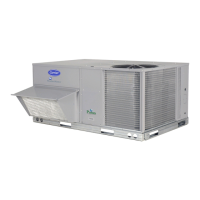
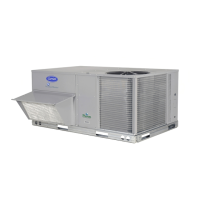
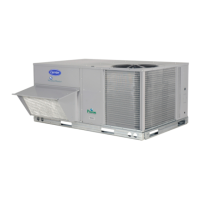
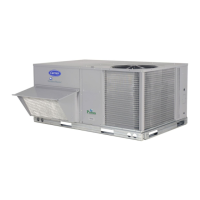





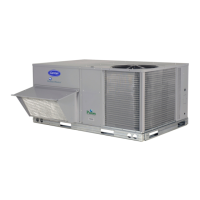


